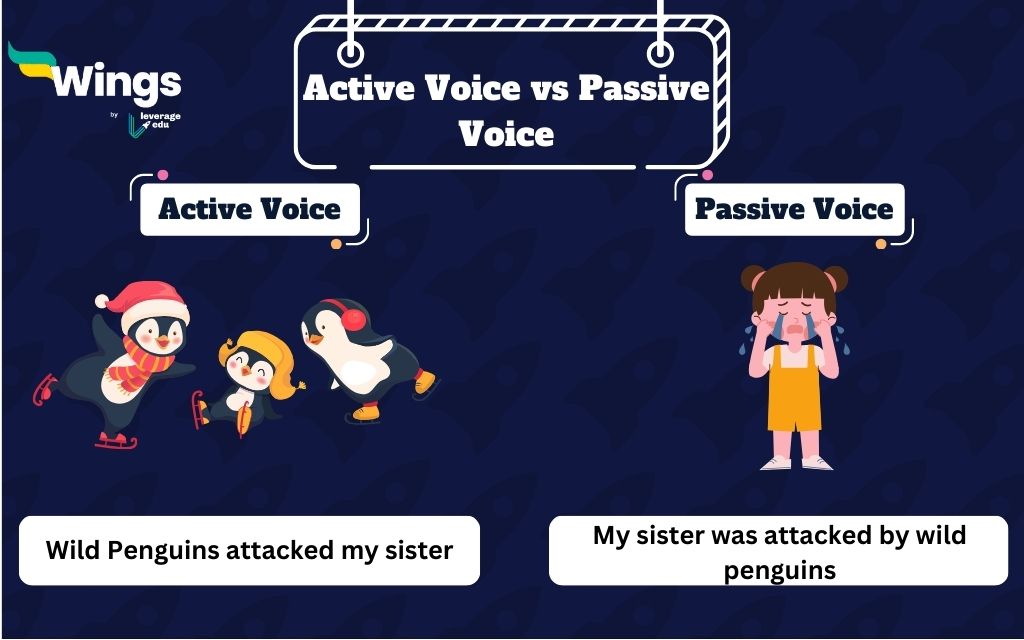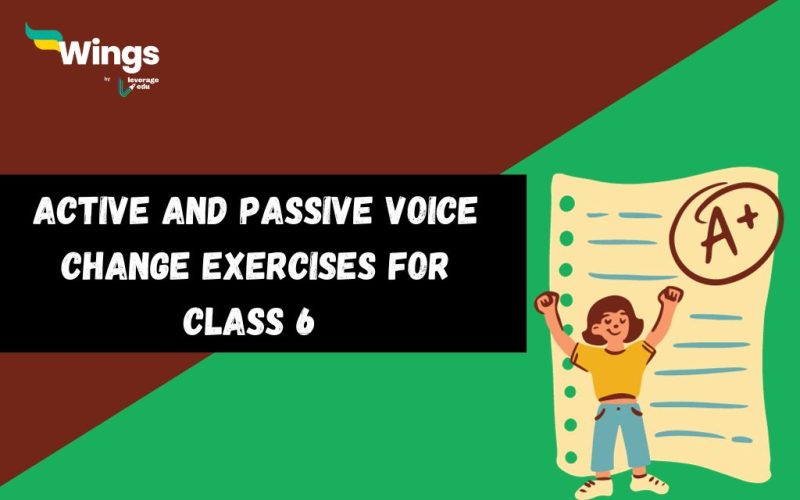Active voice enhances clarity and directness, engaging readers with a dynamic focus on the action’s doer. Passive voice, is useful for formality and shifting emphasis, especially when the doer is deemphasized or unknown, and it aids in avoiding direct blame. The effective use of both active and passive voices allows writers to tailor their communication for optimal impact and effectiveness. This blog article will help the students of class 6 to learn about the new concept of voice based on their learning of subject, verb, and object.
This Blog Includes:
- What is Subject, Verb, And Object?
- What is Voice?
- What Are Active and Passive Voices?
- Changes of Pronouns in Active and Passive Voice
- Rules for Change in Tense For Active and Passive Voice
- Practice Exercise of Active and Passive Voice For Class 6 with Answers
- Active and Passive Voice Change Exercise For Class 6 Students PDF
- Bonus Active and Passive Voice Change Exercise For Class 6 with Answers
- FAQs
Explore Now Test Your English Proficiency with this Editing Quiz!
What is Subject, Verb, And Object?
These three things form the main part of the sentence around which the sentence is structured.
Subject: Who?
The subject is the doer of the action or the one being described in the sentence.
Example: The cat sat on the windowsill.
Verb: What action?
The verb is the action or state of being expressed in the sentence.
Example: The cat sat on the windowsill.
Object: Where?
The object is the receiver of the action or the one being affected by the action.
Example: The cat sat on the windowsill.
Also Read: Tenses Rules: Charts, Examples, Types [PDF Available]
What is Voice?
In a sentence, voice refers to the person performing the action. Let’s say Samantha is a superhero with the ability to fly. Samantha is the one performing the action in this active voice sentence—she is the one taking flight. However, Samantha isn’t the one flying in a passive-person sentence; either she is being helped by someone else or the flying is happening to her. The primary distinction is that the subject (Samantha) is the one carrying out the action in the active voice, whereas the subject is receiving the action in the passive voice.
What Are Active and Passive Voices?
Active Voice:
When the subject in the sentence acts, the verb is said to be in active voice.
For Example
Sita is drinking water.
( Here Sita is the subject and drinking is the verb. Sita is the doer of the action here so the verb is in active voice.)
Passive voice:
When the subject in the sentence receives the action instead of performing it, the verb is said to be in a passive voice.
For Example
Water is being drunk by Sita.
(Here Sita is receiving the action of Drinking Water therefore we can say that the verb is in passive voice.)

In the example mentioned above, the word ‘attacked’ is the action and ‘my sister’ is the subject.
Whereas, in the next sentence, ‘my sister’ is the subject and ‘was attacked’ is the action.
Also Read: Reported Speech Rules With Exercises
Changes of Pronouns in Active and Passive Voice
These rules will help you change pronouns from active to passive voice.
| Active Voice | Passive Voice |
| I | Me |
| We | Us |
| You | You |
| He | His |
| She | Her |
| It | It |
| They | Them |
Rules for Change in Tense For Active and Passive Voice
Learn the rules of change in tenses through this table:
| Tense | Indefinite | Continuous | Perfect |
| Present | is/am/are + verb in the third form is seen/ am seen/ are seen | is/am/are + being + verb in third form is being/ seen/am being seen/are being seen | has/have + been + verb in third form has been seen/have been seen |
| Past | will/shall + be + verb in the third form will be seen/shall be seen | was/were + verb in the third form was seen/were seen | was/were + being + verb in the third form was being seen/were being seen |
| Future | is/am/are + being + verb in the third form is being/ seen/am being seen/are being seen | No change | had + been + verb in the third form had been seen |
Note: We cannot change the tense of the following tenses while changing them from active to passive.
1. Present Perfect Continuous.
2. Past Perfect Continuous.
3. Future Continuous.
4. Future Perfect. Continuous.
Also Read: Reported Speech Rules With Exercises
Practice Exercise of Active and Passive Voice For Class 6 with Answers
Instructions: Pick out the subject, verb, and object in each sentence.
- The dog chases the ball.
- She reads an interesting book.
- The students answer the questions in class.
- We bake cookies for the school event.
- The sun warms the earth.
- I eat a delicious sandwich for lunch.
- They plant flowers in the garden.
- The teacher teaches a new lesson.
- He kicks the soccer ball into the goal.
- The mechanic fixes the car.
- We watch a movie on Friday nights.
- Mom cooks dinner for the family.
- The baby laughs at the funny clown.
- The artist paints a beautiful landscape.
- The children play in the park.
Answers:
- The dog (subject) chases (verb) the ball (object).
- She (subject) reads (verb) an interesting book (object).
- The students (subject) answer (verb) the questions (object) in class.
- We (subject) bake (verb) cookies (object) for the school event.
- The sun (subject) warms (verb) the earth (object).
- I (subject) eat (verb) a delicious sandwich (object)for lunch.
- They (subject) plant (verb) flowers (object)in the garden.
- The teacher (subject) teaches (verb) a new lesson. (object)
- He (subject) kicks (verb) the soccer ball (object) into the goal.
- The mechanic (subject) fixes (verb) the car (object).
- We (subject) watch (verb) a movie (object) on Friday nights.
- Mom (subject) cooks (verb) dinner for the family.
- The baby (subject) laughs (verb) at the funny clown.
- The artist (subject) paints (verb) a beautiful landscape.
- The children (subject) play (verb) in the park.
Active and Passive Voice Change Exercise For Class 6 Students PDF
Take a look at this PDF which we have prepared for you to solve the exercise on Active and Passive Voice for Class 6 students. You can easily save and download this PDF for future reference.
Bonus Active and Passive Voice Change Exercise For Class 6 with Answers
Instructions: Convert the following sentences from Active Voice to Passive Voice.
- The dog chases the ball.
- She reads an interesting book.
- We bake cookies for the school event.
- The students answer the questions in class.
- I eat a delicious sandwich for lunch.
Check Answers:
- The ball is chased by the dog.
- An interesting book is read by her.
- Cookies are baked by us for the school eve
- The questions are answered by the students in class
- A delicious sandwich is eaten by me for lunch.
FAQs
Active voice: The subject is the doer or performs the action.
Passive voice: The subject receives the action, and the focus is on the action or the object.
The subject is the doer of the action or the one being described.
The verb is the action or state of being in the sentence.
Active voice adds clarity and directness to sentences, engaging readers by emphasizing the doer of the action.
Explore more exciting reads below!
This was all about the “active and passive voice for Class 6.” Hopefully, you understood the concept and where it’s used. You can also follow Leverage Edu for more exciting and informative blogs.
 One app for all your study abroad needs
One app for all your study abroad needs















 60,000+ students trusted us with their dreams. Take the first step today!
60,000+ students trusted us with their dreams. Take the first step today!

